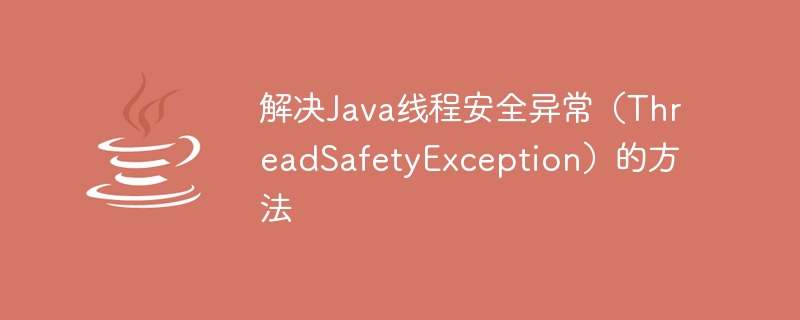Home >Java >javaTutorial >Methods to solve Java thread safety exception (ThreadSafetyException)
Methods to solve Java thread safety exception (ThreadSafetyException)
- 王林Original
- 2023-08-17 13:52:461327browse

Methods to solve Java thread safety exceptions (ThreadSafetyException)
In multi-threaded programming, thread safety exceptions are a common problem. When multiple threads access a shared resource at the same time, data inconsistency or other undefined behavior may result. To solve this problem, Java provides some mechanisms to ensure thread safety. This article describes some common workarounds and provides corresponding code examples.
- Use the synchronized keyword
The synchronized keyword is a thread synchronization mechanism provided by Java. It can be used to decorate methods or code blocks to ensure that only one thread can execute the decorated code at the same time. The following is an example of using the synchronized keyword to solve thread safety issues:
public class Counter {
private int count = 0;
public synchronized void increment() {
count++;
}
public int getCount() {
return count;
}
}In the above example, by adding the synchronized keyword to the increment method, the atomicity of the method is ensured. Even if multiple threads call the increment method at the same time, they will be executed in sequence, avoiding the problems of race conditions and data inconsistency.
- Using the Lock interface
In addition to using the synchronized keyword, you can also use the Lock interface provided by Java to achieve thread synchronization. The Lock interface provides a more flexible locking mechanism and can achieve finer-grained control. The following is an example of using the Lock interface to solve thread safety issues:
import java.util.concurrent.locks.Lock;
import java.util.concurrent.locks.ReentrantLock;
public class Counter {
private int count = 0;
private Lock lock = new ReentrantLock();
public void increment() {
lock.lock();
try {
count++;
} finally {
lock.unlock();
}
}
public int getCount() {
return count;
}
}In the above example, thread safety of the count variable is achieved by using an instance of the ReentrantLock class to acquire and release the lock. access.
- Using atomic classes
Java provides some atomic classes, such as AtomicInteger, AtomicLong, etc., which can implement thread-safe self-increment, self-decrement and other operations. The following is an example of using an atomic class to solve thread safety issues:
import java.util.concurrent.atomic.AtomicInteger;
public class Counter {
private AtomicInteger count = new AtomicInteger(0);
public void increment() {
count.incrementAndGet();
}
public int getCount() {
return count.get();
}
}In the above example, by using the AtomicInteger class, we can ensure that the operation on the count variable is atomic and avoid threading Security Question.
Summary:
In multi-threaded programming, thread-safe exceptions are a problem that requires attention. In order to solve thread safety issues, Java provides a variety of mechanisms, such as using the synchronized keyword, Lock interface, and atomic classes. Choosing the appropriate mechanism can be determined based on specific needs and scenarios. By using these solutions appropriately, we can ensure the correctness and stability of the program in a multi-threaded environment.
The above are three methods and corresponding code examples for solving Java thread safety exceptions. I hope it will be helpful to readers. In actual development, it is necessary to carefully analyze the problem and choose an appropriate solution to ensure thread safety while improving the performance and concurrency of the program.
The above is the detailed content of Methods to solve Java thread safety exception (ThreadSafetyException). For more information, please follow other related articles on the PHP Chinese website!

